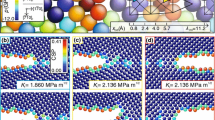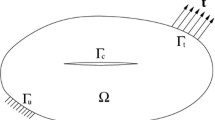Abstract
The validity and predictive capability of continuum models of fracture rests on basic informations whose origin lies at the atomic scale. Examples of such crucial informations are, e.g., the explicit form of the cohesive law in the Barenblatt model and the shear-displacement relation in the Rice-Peierls-Nabarro model. Modem approaches to incorporate atomic-level information into fracture modelling require to increase the size of atomic-scale models up to millions of atoms and more; or to connect directly atomistic and macroscopic, e.g. finite-elements, models; or to pass information from atomistic to continuum models in the form of constitutive relations. A main drawback of the atomistic methods is the complexity of the simulation results, which can be rather difficult to rationalize in the framework of classical, continuum fracture mechanics. We critically discuss the main issues in the atomistic simulation of fracture problems (and dislocations, to some extent); our objective is to indicate how to set up atomistic simulations which represent well-posed problems also from the point of view of continuum mechanics, so as to ease the connection between atomistic information and macroscopic models of fracture.
Similar content being viewed by others
References
H. Liebowitz (ed.), “Fracture: An Advanced Treatise. Vol.11: Mathematical Fundamentals”, Academic Press, New York, 1968; G.C. Sih, H. Nisitani and T. Ishihara (eds.), “Role of Fracture Mechanics in Modem Technology”, Elsevier, Amsterdam, 1987; M.H. Aliabadi and D.P. Rooke, “Numerical Fracture Mechanics”, Kluwer, Dordrecht, 1991.
A.A. Griffith, Philos. Trans. Royal Soc. (London) A 221 (1920) 163.
R.L. Blumberg Selinger, J.J Mecholsky, A. E. Carlsson and E. R. Fuller Jr (eds.), “Fracture-Instability Dynamics, Scaling and Ductile/Brittle Behavior”, MRS vol. 409, Pittsburgh, 1996; A.K. Cheetam et al., J. Comput.-Aided Mater. Design 3 (1996) 1.
W.W. Gerberich et al., Acta Metall. Mater. 43 (1995) 1569.
W.T. Ashurst and W.G. Hoover, Phys. Rev., B 14 (1976) 1465.
P.S. Lomdahl et al., Int. J. Mod. Phys. C42 (1993) 1075.
F.F Abraham et al., Phys. Rev. Lett. 73 (1994) 272.
B.L. Holian and R. Ravelo, Phys. Rev. B 51 (1995) 11275.
A. Nakano, R.K. Kalia and P. Vashista, Phys. Rev. Lett. 73 (1994) 2336.
S.J. Zhou et al., Phys. Rev. Lett. 76 (1996) 2318.
D. Mullins and A. Dokainish, Phil. Mag. A 46 (1982) 771.
S. Kohloff, P. Gumbsch and H.F. Fischmeister, Phil. Mag. A 64 (1991) 851.
E.B. Tadmor, M. Ortiz and R. Phillips, Phil. Mag. A 73 (1996) 1529.
R. Miller and R. Phillips, Phil. Mag. A 73 (1996) 803.
E. Kaxiras and M.S. Duesbery, Phys. Rev. Lett. 70 (1993) 3752.
F. Cleri, S. Yip, D. Wolf and S.R. Phillpot, Phys. Rev. Lett. 79 (1997) 1309; Acta Mater. 45 (1997) 4993.
A.E.H. Love, Appendix B in “A Treatise on the Mathematical Theory of Elasticity”, 4th ed., F. Dover, New York, 1944; M. Born and K. Huang, “Dynamical Theory of Crystal Lattices”. Oxford University Press, Oxford, 1954.
Cleri, S.R. Phillpot, D. Wolf and S. Yip, J. Am. Cer. Soc. 81 (1998) 503.
M.P. Allen and D.J. Tildesley, “Computer simulation of liquids”, Oxford Science Publications, Oxford, 1989.
M. Parrinello and A. Rahman, J. Appl. Phys. 52 (1981) 7182.
K.S. Cheung and S. Yip, Phys. Rev. Lett. 65 (1990) 2804.
R.G. Hoagland, M.S. Daw and J.P. Hirth, J. Mater. Res. 6 (1991) 2565.
S.G. Lekhnitskii, pp. 153–162 in “Theory of Elasticity of an Anisotropic Elastic Body”, Holden-Day, San Francisco, 1963.
V.Z. Parton and E.M. Morozov, pp. 103–123 in “Mechanics of Elastic-Plastic Fracture”, Hemisphere, Washington, 1989.
V. Bulatov, F.F. Abraham, L. Kubin, B Devincre and S. Yip, Nature 391 (1998) 669.
Author information
Authors and Affiliations
Rights and permissions
About this article
Cite this article
Cleri, F. Atomistic Aspects of Fracture Modelling in the Framework of Continuum Mechanics. MRS Online Proceedings Library 538, 441–451 (1998). https://doi.org/10.1557/PROC-538-441
Published:
Issue Date:
DOI: https://doi.org/10.1557/PROC-538-441




